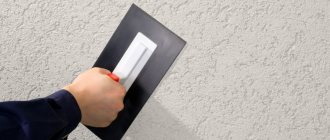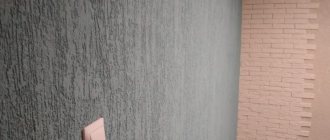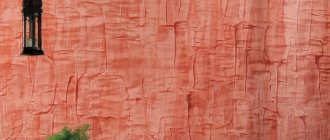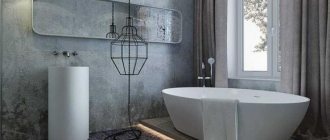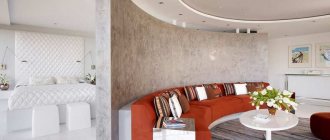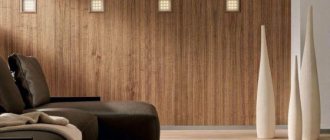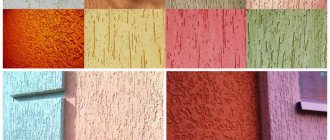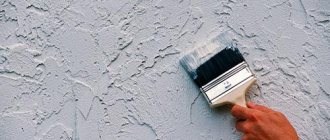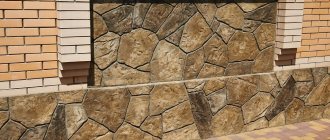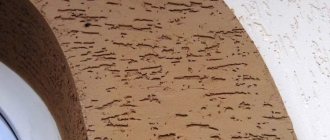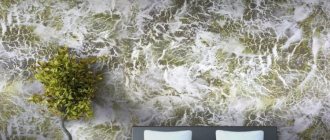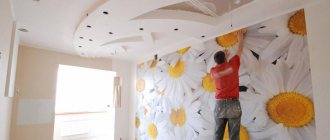SHARE ON SOCIAL NETWORKS
FacebookTwitterOkGoogle+PinterestVk
One of the most interesting, original, cheap and easy-to-apply options for surface cladding is considered to be textured “bark beetle” plaster. Using this material, which is used for both exterior and interior decoration, you can create a unique, colorful and durable surface. The technology for applying bark beetle plaster is described in detail in this article.
The use of bark beetle plaster is one of the most popular methods of finishing both external walls and interior spaces.
Types and composition
Various compositions are used to make bark beetle:
- Acrylic mixture
. The plaster has good adhesion and resistance to moisture. Widely used in swimming pools and other places where humidity is high.
- Silicate
. Plaster is produced based on potassium silicate. The material is characterized by high vapor permeability (due to the presence of water-repellent components). The mixture is available in the market in various color options.
- Silicone
. It does not crack, is resistant to moisture, and is more durable than other types of plaster.
- Cement-lime
. Quartz sawdust is added to the composition, the mixture can withstand low temperatures.
Before purchasing, you should correctly calculate the amount of material that will be required for finishing.
Composition of textured bark beetle plaster:
- marble chips;
- acrylic, silicone, gypsum or silicate components;
- aggregate in the form of finely ground sand and limestone;
- plasticizers that provide elasticity and strength of the material.
The bark beetle dries quickly after application. The texture on the surface is achieved due to the presence of small stones in the composition (marble sawdust, various mineral mixtures, acrylic dispersions, including titanium dioxide).
The structure of the mixture allows you to create different textures on the surface (raindrops, tree bark, circular lines, etc.). There are 2 types of bark beetle facade plaster available on the market: dry mass or ready-mixed. The second one is more convenient to use, but costs more. Dry plaster is diluted with special dyes.
You can find different shades of bark beetle on the market. The following colors are most often used for decorating facades with bark beetle: coffee, light gray, beige.
The choice of plaster depends on the type of surface:
- For concrete foundations, experts recommend a cement-lime mixture.
- Brick walls can be finished in any variety.
- For wooden walls, lime or gypsum material is best suited. Additionally, a gypsum reinforcing mesh is installed.
Bark beetle base
The basis for bark beetle plaster can be different: cement, brick, gypsum wall finishing. Many people insulate their houses with polystyrene foam, which is covered with a layer of putty under the plaster.
A reinforcing mesh should be installed over the foam plastic underneath the bark beetle.
- One rule is useful: if you are planning significant work on finishing the house (foam insulation, putty, plaster), you need to think through everything as carefully as possible in advance, use materials of the same brand.
- This is also provided for by the companies themselves, which produce products that combine well with each other. It is also important to immediately decide on the style and color of the finish, so that you do not have to putty, replaster, and one color does not break through another.
On large areas of finishing, especially in bright lighting inside or outside the building, errors and miscalculations are very noticeable.
Advantages and disadvantages of using on the wall
Bark beetles are used to decorate the facade of a house for a number of reasons.
Among them are the following:
- The house is treated with plaster to protect the surface from external factors (rain, fog, condensation).
- Thanks to the hydrophobic substances contained in the composition, the wall of the building remains almost dry.
- A high-quality bark beetle coating helps to visually hide defects on the wall of a building.
- The bark beetle is beautifully colored, you can even use several shades.
- Resistance to the appearance of various cracks, the effect is achieved due to the addition of polymer substances to the composition.
- If the technological aspects are observed, the original appearance of the coating in the interior will last up to 15 years, and of the facades - up to 7 years.
- The material is considered environmentally friendly. This allows it to be used in a wide variety of places.
- The bark beetle is easy to care for. The surface can be cleaned with a vacuum cleaner, sponge, brush, and detergent.
- Original appearance. The coating after application resembles the active work of a bark beetle on the surface of wood (carnivore). The name plaster was coined in connection with this fact.
Other benefits:
- strength and durability;
- resistance to ultraviolet rays;
- relatively low cost;
- resistance to mechanical damage;
- does not allow water to pass through or absorb it;
- the rich color lasts for a long time;
- allows the walls to “breathe”;
- has low thermal conductivity;
- not afraid of fire;
- does not emit toxic substances when heated;
- resistance to mold and fungi;
- practicality;
- ease of application of bark beetle plaster;
- scratch resistance.
Bark beetle facade plaster is plastic, waterproof, does not ignite, and can withstand high and low temperatures, which makes it indispensable in construction.
Like other finishing materials, bark beetle has disadvantages. One of them is mechanical instability, and bark beetle application requires the correct air temperature and humidity.
Preparation of plaster
After the cement-sand layer has completely dried, you can proceed directly to preparing the Bark Beetle plaster and applying it. It is important to calculate the time correctly here, since one wall needs to be tiled at a time. This involves joining the newly applied area with the previous one that has not yet dried. In this case, the surface will have a monolithic structure without visible joints or differences.
When preparing the Bark Beetle plaster mixture, you must strictly follow the manufacturer's instructions. But in general the process has the following sequence:
- A clean container is prepared;
- Fill with the amount of water at room temperature specified in the recommendations;
- The dry mixture of facade plaster is gradually poured in and at the same time continuously mixed so that it does not form lumps;
- Stirring continues until a homogeneous mixture is obtained;
- The container is closed;
- After 10-15 minutes. stirs again.
Under no circumstances should you add water to ready-made plaster; this can lead to its delamination and loss of necessary characteristics.
During operation, the mixture should not harden; it should be stirred regularly. The average time for using ready-made Bark Beetle plaster is 1.5-3 hours. More precise information should be provided by the manufacturer in the instructions for use.
Application technology for facades and interior work
The application technique is not much different from the standard method; the decorative material can be applied independently using a spatula. The entire process of finishing the facade with bark beetle consists of 3 stages: preparation of the base, plastering and painting. Each of them is performed sequentially and strictly in accordance with the instructions.
How to apply bark beetle:
- First, prepare the base. The wall is cleaned, the unevenness is sealed with putty. If this procedure is not followed, any minor defects may appear after the work is completed.
- After preparing the solution, immediately begin applying it, because the mixture hardens quickly. The bark beetle is applied to the wall using a steel spatula (adjacent ceilings and other surfaces are protected with a special film). The application technology is similar to standard putty.
- At the end of the process, the remaining material on the spatula is thrown into another container (it is not reused for plastering). It is recommended to do the work in pairs: one person is needed to distribute the mixture on the wall, and the other is needed to level the layer and form the texture.
- After applying the layer, a texture is created on the surface using a plastic trowel. The tool is used for crushing and rolling out large decorative granules in the composition. Experts advise holding the tool at an angle of 60°; it is also important to ensure that the pattern is the same everywhere.
- Make circular or straight movements with a spatula to form texture on the surface. Patterns on the wall can be horizontal, vertical, variable, chaotic. To create the “lamb” effect, they use the following trick: rub the mixture in a circular motion. It takes 1-5 days for the mixture to dry completely (depending on the type of material). After this, they begin to paint the walls.
- Apply the bark beetle to the wall at an angle of 40-50°.
- To paint the facade, it is recommended to use a color that matches the plaster. The drying time of the paint lasts from 6 hours.
- At the final stage, protective acrylic varnish is applied. It can be matte or glossy and there are different shades available in the market. Before applying the varnish, allow the coating to dry (for 24 hours). Acrylic varnish with opalescent or metallic shades is often used to decorate walls.
Preparing the mixture for plastering walls
To increase the service life of decorative plaster, you should properly prepare the composition. You need to know how to make bark beetle plaster with your own hands.
The algorithm is as follows:
- Most often, about 250 ml of water is required for 1 kg of dry mixture.
- Mixing the ingredients can be done manually with a spatula, but it is faster and more convenient to prepare the solution using a mixer.
- The prepared mass should not contain lumps or excess moisture; the consistency of the solution should resemble a thick cream.
- If the mixture is too dry, it will increase material consumption and may cause difficulties during application.
- If the plaster is too liquid, then defects may appear on the wall; in addition, it is difficult to form a texture using liquid mixtures.
How to make bark beetle plaster with your own hands
Before making a bark beetle, it is recommended that you familiarize yourself with the algorithm of actions:
- The mass is prepared in a bucket. First, pour the liquid, then pour in the decorative material, stirring the composition. The ratio of dry ingredients and water should be 1:3. It may vary from manufacturer to manufacturer (be sure to read package instructions before mixing).
- To achieve uniform distribution of all binders, especially large granules that form the texture, the mass must be mixed well.
The drying time of the layer may vary for different compositions (depending on the quality of the plaster and the type of mixture).
How to properly prepare a mixture for decorating a house with bark beetle:
- the liquid for diluting the dry mass should be at room temperature;
- a special device is used to create the solution;
- Stir the mixture until smooth.
How to properly apply decorative bark beetle to the wall
To achieve a high-quality coating, you need to know how to plaster with bark beetle.
The following procedure is used:
- Ultraviolet rays should not reach the plaster during application; they also try to prevent drafts so that the created layer can dry evenly.
- There is no point in applying bark beetle to smooth glass or metal surfaces, because... low adhesive ability will not allow the mass to stick
- To ensure that the mixture adheres evenly to the base and lasts as long as possible, the surface is first coated with gypsum or cement materials.
- The recommended layer thickness is 3 mm. The parameter may vary among different manufacturers (depending on the type of grain size and quality of the material).
- At the initial stage of work, you should prepare the base well (remove old paint, stains, dust, mold). In addition, it is important to level the surface (eliminate depressions and bulges).
- To avoid chemical incompatibility, the plaster and primer must be from the same manufacturer.
- If the cladding is carried out in a room with high humidity, then to prevent the development of fungus and mold, the base should be treated with an antifungal agent.
- The primer is applied by spray, brush or roller. A high-quality primer not only helps improve adhesion, but also prevents the formation of bacteria.
Every master should know how to apply decorative plaster and what details to take into account.
These include the following:
- Temperature. It is recommended to apply the layer to the surface at a temperature of +5...+30°C.
- Humidity should not exceed 80%.
- After preparing the solution, it should be immediately applied to the surface. Otherwise the mixture will harden.
- For painting plaster, choose silicate or silicone compounds. Do not apply paint immediately after applying a layer (at least 3 days must pass). To apply paint, use tools such as a brush, roller or spray gun.
Do-it-yourself application of bark beetle to walls - drawing
Various textures are used to decorate the facade of a building. Information on how to apply the plaster is indicated on the packaging.
Jets of rain
If you process the surface from top to bottom and back, the effect of falling drops will form on the wall.
slanting rain
To achieve this effect, spread the plaster at a special angle.
Bark beetle
Using this material, they create an original, colorful and durable surface.
Horizontal
Horizontal bark beetle plaster looks good in the interior.
Two-color
Often two-tone painting is used, which includes, for example, pink and red tones. The first layer is applied with a roller, it helps to paint over all dents and grooves. After drying, apply a layer of a lighter tone using a flat rubber spatula. The result is a dark base of the facade and a light bark beetle pattern.
Painting a plastered surface
The applied solution can be painted with façade paints containing silicone dyes. Painting the facade with bark beetle will be more attractive if you apply two layers.
Algorithm of actions:
- It is desirable that the first color of plaster applied to the facade be dark. Attention is paid to the depressions. The second layer may be lighter. The important thing here is not to tighten the dents and the bottom of the grooves.
- The work is carried out using a tool - a paint roller with a flat surface. One more point: the owner of the house can choose the paint for the facade at his own discretion.
Use in interior and exterior decoration (on the facade)
The possibilities for using this material are almost endless. The mixture adheres well to bricks, concrete, cement plaster, plasterboard, polystyrene boards and all types of moisture-resistant plywood. The mixture can even be used to finish sandwich panels.
The bark beetle is widely used not only in Russia, but also abroad. Versatile material suitable for indoor and outdoor use. The decorative mixture can be used for finishing both public and private buildings. Even when using strict tones of the mixture, the façade of the building looks bright and attractive.
The characteristics of the material explain why this modern finish is beneficial: bark beetle based on silicone and acrylic binders provides high resistance to weathering and good vapor permeability.
Thanks to excellent adhesion to the facade, even application and skillful selection of composition, you can get many interesting shades and textures. The bark beetle is well suited for decorating the interior of new buildings and even for the restoration of old premises.
How to use raw materials?
"Bark beetle" can be used for various purposes. As already mentioned, it is used to decorate walls and facades. The result that the owner of the object can achieve depends only on him.
They can be used to decorate part of the room (apply plaster to the ceiling, walls). Naturally, it should be taken into account that applying raw materials to surfaces with which it will have poor adhesion (glass, walls of a metal garage) is not advisable. But with brick, concrete, and drywall, the material will have excellent adhesion.
Important! This type of plaster is an independent coating finish. Therefore, they need to decorate the walls. The material is not suitable for filling deformations or holes in the coating.
Review of manufacturers
Many enterprises produce bark beetle facade paint. The top sellers of quality products are:
- Unis
- Dufa
- Ceresit
- Baumit
The quality of the composition of the plaster mortar from the above-mentioned manufacturers is evidenced by numerous flattering reviews from home owners, specialists and experts in the construction industry.
Approximate prices for decorative bark beetle plaster
| View | Brand | Package size, kg | price, rub. |
| Acrylic | Ceresit CT64 | 25 | 1920 |
| Universal | Bergauf | 25 | 640 |
| Acrylic | Baumit Duotop-Putz | 25 | 710 |
| Mineral | Founds Exterwell T-27 | 25 | 482 |
| Mineral | Unis | 25 | 700 |
| Acrylic | Bayramix | 20 | 2060 |
| Acrylic | Dufa | 20 | 2100 |
In the interior
Rough bark beetle plaster is not suitable for every style.
Decorative plaster successfully realizes itself in the loft style interior , which is gaining popularity. The more the room resembles a factory premises, the better. The “bark beetle” with its grooves highlights such an interior well.
"Bark beetle" in loft style
The minimalist style also goes well with bark beetle plaster. Calm, pastel colors are ideal for decorating a bedroom. To create an unusual interior, there is no need to plaster the entire room; it is enough to treat one wall. You can arrange the lighting in such a way that the wall sparkles and looks advantageous.
Decorative plaster in a minimalist style in the bedroom
Interestingly, this material will look in a rustic or chalet style. Wood, stones, and decorative plaster are very useful in such an interior . If you have a fireplace, you can treat the wall behind it with bark beetle. Cozy lighting will highlight the relief structure, and the flame will cast fancy shadows on the wall.
"Bark beetle" in the living room with a fireplace
For practicality, you can apply bark beetle plaster in the hallway or corridor . Thanks to its durable characteristics, the bark beetle will last a long time in a small room and will withstand abrasion and repeated touches. After a few years, it is enough to paint the surface to update the interior.
Exquisite corridor with decorative plaster
Creating an invoice
The most important and creative stage in the work is the creation of a textured surface, which appears due to the movement of marble chips during rubbing. You can start rubbing after the layer of plaster has dried a little. The technology for creating texture is as follows: a plastic grater or trowel is applied to the wall and pressed lightly. The grater movements should be uniform and repeating, their nature depends on what kind of pattern you want to get.
- The classic pattern of beetle-eaten wood can be obtained by uneven circular and arched movements of the grater in different directions.
- The “Rain” pattern is obtained by rubbing the plaster with long, continuous movements from top to bottom, vertically or diagonally.
- “Travertine” - an imitation of the surface of a stone - is done with short, jerky movements in different directions.
- The “Lamb” pattern can be made using circular movements of small amplitude.
- The woven pattern is created by alternating movements from bottom to top and from left to right. Vertical strokes are made long, horizontal movements are performed with quick short strokes.
After the plaster has dried, the wall can be further processed with sandpaper, paying special attention to the joints.
Approximate material consumption
The average consumption of bark beetle plaster is from 2.4 to 4 kg per 1 m2. sq. and depends on several indicators:
- base material;
- filler grain size;
- thickness of the finishing layer;
- application technologies.
Let's consider the difference in plaster consumption per 1 m2 using the example of different types of products from the popular Ceresit brand.
Polymer cement or mineral plasters
- Ceresit ST-35 (grain size - 2 mm) - up to 2.8 kg per 1 m2;
- ST-35 (grain size - 2.5 mm) - up to 3.5 kg per 1 m2;
- ST-35 (grain size - 3.5 mm) - up to 4.9 kg per 1 m2;
- Ceresit CT-36 (grain size - 2 mm) - from 2 to 5 kg per 1 m2, depending on the application method.
USEFUL INFORMATION: Installation of ventilation in an apartment with your own hands
Acrylic
- ST-63 (grain 3 mm) - up to 4.5 kg per 1 m. sq.;
- ST-64 (grain 2 mm) – from 2.7 to 3 kg per 1 m. sq.
Silicate
- ST-73 and ST-75 (2 mm) - up to 3 kg per 1 m. sq.;
- ST-73 and ST-75 (3 mm) - up to 4.5 kg per 1 m. sq.
Silicone
- CT-75 (2mm) - up to 3 kg per 1m. sq.;
- CT-75 (3mm) - 4.5 kg per 1m. sq.
Silicate-silicone
- ST-175 (2 mm) - up to 3 kg per 1 m. sq.
It is difficult to determine the exact amount of mixture that will be spent on finishing; when purchasing, you can rely on the data specified by the manufacturer, adding 5-10% to this value. In practice, the consumption of plaster per 1 m2 may differ from the figure stated by the manufacturer, since the recommended consumption for a leveled surface is indicated on the packaging. Any unevenness on the walls entails an increase in material consumption. In addition, it is quite difficult to make an even layer over the entire surface of the walls without many years of experience.
Material consumption also depends on the preliminary preparation of surfaces. In order to be able to get by with less plaster, before applying it, in addition to a special primer with quartz sand, which increases adhesion, you must additionally use a deep penetration acrylic primer.
